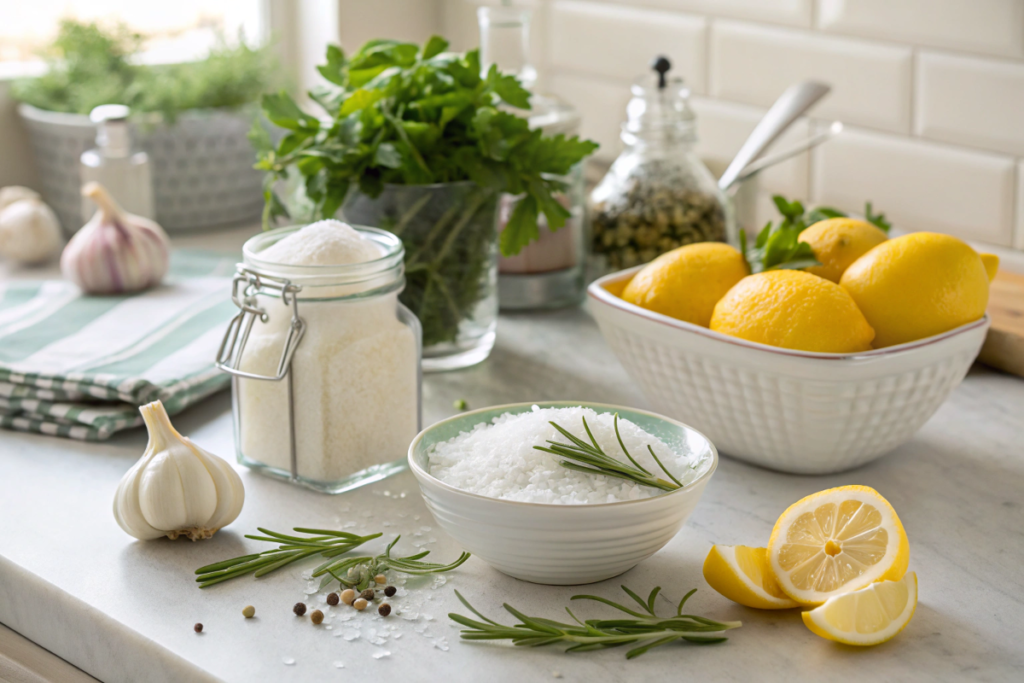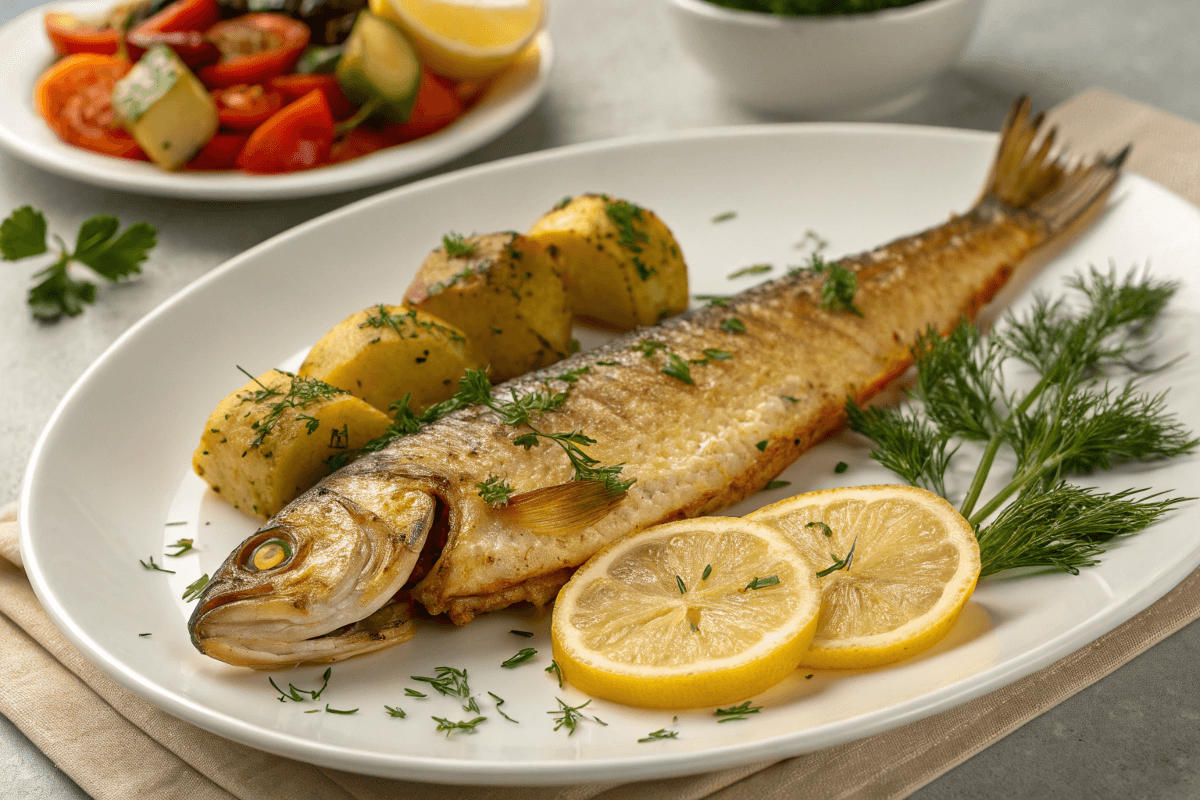The first time I tasted a perfectly smoked walleye, I knew something magical had happened. Growing up in North Dakota, fish was more than just food. It was a link to our traditions and the lakes and rivers of our summers.
If you’ve ever had dry, tasteless fish, your cooking days are about to get better. A fish brine recipe is not just a cooking trick. It’s a way to change the taste of your fish.
Brining fish keeps it moist and brings out its natural flavors. It works for paddlefish from local waters or any fish you want to try. This method makes your seafood juicy, tender, and full of flavor.
In this guide, we’ll show you how a simple brine can make your fish unforgettable. You’ll learn pro techniques to make every fillet a feast of taste and texture.
Understanding Fish Brining Basics
Discover the art of fish brining, a culinary technique that transforms ordinary seafood into an extraordinary dining experience. Curing fish through brining is more than just a cooking method – it’s a science that elevates flavor and texture.
What is Fish Brining?
Fish brining is a specialized process of soaking fish in a saltwater solution. Your fish brine recipe acts as a flavor enhancer and moisture preserver. The salt solution penetrates the fish’s cellular structure, creating a more succulent and flavorful result.
Benefits of Brining Fish
- Enhances natural fish flavors
- Increases moisture retention
- Reduces excessive “fishiness”
- Improves overall texture
- Prepares fish for various cooking methods
Science Behind the Brining Process
The magic of salting fish happens through osmosis. When you submerge fish in a brine, salt molecules begin to break down protein structures, allowing water and seasonings to penetrate deeply.
“Brining transforms an ordinary piece of fish into a culinary masterpiece.” – Seafood Chef
Successful brining depends on precise salt ratios and timing. A typical seafood brine recipe includes:
| Ingredient | Quantity | Purpose |
|---|---|---|
| Kosher Salt | 1/4 cup | Primary seasoning |
| Sugar | 1/4 cup | Flavor balance |
| Water | 4 cups | Brining liquid |
| Lemon | 1 whole | Aromatic enhancement |
Understanding the nuances of curing fish will help you create perfectly seasoned, moist, and delicious seafood every time.

Essential Ingredients for the Perfect Fish Brine Recipe
Creating a top-notch fish marinade starts with the right brine ingredients. Choosing high-quality components boosts flavor and texture. This makes your fish curing methods better.
The base of a great fish brine needs a mix of key ingredients:
- Kosher salt (better than iodized salt)
- White sugar
- Brown sugar
- Water
For the best results, follow a specific ratio. For one gallon of water, use:
- 1 cup kosher salt
- 1 cup white sugar
- 1 cup brown sugar
To make your fish marinade even better, add extra flavor ingredients:
- Citrus fruits (like lemon juice)
- Black pepper
- Garlic
- Onions
- Hot pepper sauce
- Crab and shrimp seasoning mix
Pro tip: Kosher salt is key because it doesn’t have additives that can ruin your fish’s taste.
Your brine ingredients should blend to create a flavorful mix. This mix should enhance the fish’s taste without changing its texture. The goal is to find the perfect salt-to-water ratio for seasoning.
How to Choose the Best Fish for Brining
Choosing the right fish is key for a great fish brine recipe. Not all fish are good for pickling or preserving seafood. Knowing which fish to pick can make your dish better.
Ideal Fish Types for Brining
Look for fish with certain traits when brining. The best fish include:
- Salmon (especially wild king and Atlantic)
- Trout
- Bass
- Catfish
- Paddlefish
Wild king salmon is a top pick because of its fat and flaky texture. Farm-raised Atlantic salmon is also great for brining and smoking.
Thickness and Cut Considerations
Fish thickness is very important for brining. Choose pieces that are:
- Evenly thick (1 to 1.5 inches)
- Without tears or damage
- Shaped the same for even brining
“A uniform fish cut ensures consistent flavor absorption and prevents uneven texture during the brining process.”
Fresh vs Frozen Fish Selection
Fresh fish is usually better for preserving seafood. But, high-quality frozen fish can also work well. When picking fish, look for:
- Firm, shiny flesh
- No strong fish smell
- Little ice crystals in frozen fish
Pro tip: If using frozen fish, make sure it’s fully thawed and dry before starting your brine recipe. This will help you get the best results.
Step-by-Step Basic Fish Brine Recipe
Making a great fish brine recipe is key to turning simple fish into a tasty dish. This easy fish marinade will boost your curing skills. It guarantees delicious results every time.
Your basic fish brine needs just a few ingredients. These ingredients work together to improve flavor and texture. Here’s what you’ll need:
- 4 cups cold water
- 1/2 cup fresh lemon juice
- 1/3 cup brown sugar
- 3 tablespoons kosher salt
To make your fish brine, follow these simple steps:
- Put all ingredients in a big non-reactive bowl
- Stir until sugar and salt dissolve
- Put fish fillets in the brine
- Add more water if needed to cover the fish
“The key to a perfect fish brine is balance between salt, sugar, and acidity.” – Professional Chef
When curing fish, timing is important. Refrigerate your brined fish for:
| Fish Type | Brining Time |
|---|---|
| Thin fillets | 3-4 hours |
| Thick fillets | 6-8 hours |
| Whole fish | 8-12 hours |
After brining, always rinse your fish under cool water. Then, pat it dry with paper towels before cooking. This marinade technique ensures your fish is flavorful and perfectly seasoned.
Customizing Your Fish Brine with Seasonings
Making a great fish brine recipe is more than just salt and water. The right mix of seasonings can turn your fish marinade into a dish that wows everyone. It will make your taste buds happy and impress your guests.
Exploring Herb and Spice Combinations
Choosing the right herbs and spices can really boost the flavor of your pickled fish or brine. Here are some great options:
- Mediterranean Blend: Rosemary, thyme, and oregano
- Scandinavian Style: Fresh dill and crushed garlic
- Spicy Kick: Chili flakes, coriander, and black pepper
- Asian-Inspired: Ginger, star anise, and green onions
Citrus and Aromatic Enhancements
Citrus fruits and aromatics add bright, complex flavors to your fish brine. Try these:
- Lemon and orange zest
- Lime juice for tanginess
- Fresh garlic and shallots
- Sliced ginger root
Regional Flavor Variations
Each region has its own way of making fish marinades and brines. Here are some ideas:
- Southwestern: Mesquite chips and chipotle peppers
- New England: Maple syrup and juniper berries
- Pacific Northwest: Cedar plank seasonings
- Caribbean: Allspice and rum-infused brine
Pro tip: Always balance your seasonings and avoid overwhelming the natural fish flavor.
By Aug. 10, 2024, home chefs will be getting creative with these brining techniques. They’ll be making their seafood dishes even better.
Proper Brining Times and Temperature Guidelines
When you’re making your fish brine recipe, timing and temperature are key. They can either make or break your curing fish process. The right approach ensures both safety and great flavor in your fish curing methods.
Temperature is your first critical consideration. You’ll want to keep a consistent refrigeration temperature between 38°F to 40°F during the entire brining process. This narrow range prevents bacterial growth and keeps your fish at a safe, cool temperature.
Brining Duration Guidelines
- Thin fish fillets: 4-6 hours of brining
- Medium-sized fish: 6-8 hours recommended
- Thick salmon cuts: 8-36 hours depending on size
Your brining time depends on several factors. These include fish thickness, desired flavor intensity, and your specific cooking method. A good rule of thumb is to allow approximately one hour of brining per pound of fish.
“Precision in brining is the difference between good and extraordinary seafood preparation.”
For optimal results in your fish brine recipe, always pat your fish dry after brining. Let it rest in the refrigerator for an additional 4 hours. This creates a pellicle – a tacky surface layer. It helps seasonings and smoke adhere better during subsequent cooking processes.
Pro Tips for Perfect Brining
- Use a ratio of 1 cup salt and 1 cup sugar per gallon of water
- Keep brine temperatures strictly between 38-40°F
- Never leave fish brining at room temperature
When curing fish, remember that over-brining can result in an excessively salty taste and tough texture. Always monitor your fish closely. Adjust brining times based on your specific cut and desired outcome.
Common Brining Mistakes to Avoid
Mastering the art of fish brine recipe needs careful attention. Even skilled home cooks can make mistakes that ruin their seafood. Knowing these common errors will help you brine fish perfectly every time.
Over-Brining Pitfalls
One big mistake is brining fish too long. Fish is delicate and can become too salty or mushy. The best brining time is 30 minutes to 1 hour, based on the fish’s thickness.
- Check fish thickness before brining
- Use a timer to prevent over-salting
- Rinse fish thoroughly after brining
Temperature Control Challenges
Keeping the right temperature is key in preserving seafood. Your brine and fish should stay cold, below 40°F, to stop bacteria growth. Never let brining fish sit at room temperature, as it’s unsafe.
Container Selection Errors
The wrong container can mess up your fish brine recipe. Here’s what to avoid:
- Skip aluminum containers that react with salt
- Use food-grade plastic, glass, or stainless steel
- Ensure container is large enough for fish to be fully submerged
“The right container and careful timing can transform an average fish into a culinary masterpiece.”
Avoiding these common mistakes will improve your seafood skills. You’ll make delicious, perfectly seasoned fish every time.
Preparing Fish After Brining
After you’ve made your fish brine, it’s important to prepare it right. This step turns your cured fish into a dish that will wow everyone. It’s all about getting the right texture and flavor.
Essential Post-Brining Steps
- Rinse the fish well under cool water to get rid of extra salt
- Use clean paper towels to dry the fish completely
- Put the fish on a cooling rack over a baking sheet
- Refrigerate it without a cover to form a pellicle
The pellicle is a thin, sticky layer. It’s important because it helps the smoke stick to the fish. This makes the fish taste better and look great.
Smoking and Cooking Techniques
| Smoking Method | Temperature Range | Cooking Time |
|---|---|---|
| Cold Smoking | Below 86°F | 12-30 minutes |
| Hot Smoking | Above 145°F | 15-30 minutes |
Before you start cooking, brush the fish with olive oil. This prevents it from sticking. Smoke it at 150°F, then raise the temperature to 180°F. Pro tip: Baste with honey or maple syrup every 45 minutes. This adds sweetness and depth to your smoked fish.
The key to perfect fish is patience and careful preparation after brining.
Storage Recommendations
After you’ve smoked your fish, you can store it in the fridge for up to two weeks. Make sure it’s in an airtight container. If you want to keep it longer, freeze it. Freezing can make it last up to a year.
Storage and Safety Tips for Brined Fish
Seafood preservation needs careful attention. When curing fish, right storage is key. It keeps quality high and prevents illness.
After brining your fish, follow these important storage tips:
- Wrap brined fish tightly in plastic wrap or aluminum foil
- Place in an airtight container or sealed zip-lock bag
- Refrigerate immediately after preparation
For the best preservation, consider these storage times:
- Refrigeration: Store brined fish for up to 7 days
- Freezing: Vacuum seal for extended storage up to 3 months
“Temperature control is key in preventing bacterial growth during pickling fish.”
When handling brined fish, follow strict food safety rules:
- Use separate cutting boards for raw and cooked fish
- Sanitize utensils between uses
- Ensure internal cooking temperature reaches 140°F (60°C)
Remember, proper storage is vital in fish curing. Always check for spoilage. Eat within the recommended time for the best taste and texture.
Conclusion
Making the perfect fish brine recipe is key for home cooks wanting to improve their seafood skills. It’s all about trying new ingredients and techniques. You also need to pay close attention to timing and temperature.
Brining fish is just the start of your seafood journey. Each fish type offers a chance to add new flavors. Whether it’s delicate white fish or strong bluefish, brining makes them moist and tasty. Remember, brining times vary based on the fish’s size.
When brining fish, safety and accuracy are top priorities. Use fresh ingredients and keep everything chilled. Brined fish stays good in the fridge for 3-4 days. It’s perfect for a variety of dishes, from smoked bluefish to dishes with unique flavors.
Brining fish is a skill that makes food more flavorful, tender, and juicy. With time and effort, you can make seafood dishes that rival those from restaurants. It’s all about experimenting and improving your craft.
FAQ
What is fish brining and why should I do it?
Fish brining is a cooking method where you soak fish in saltwater. It makes the fish taste better, feel softer, and stay moist. This method uses osmosis to help the fish soak up more water and seasonings.
Brining is great for wild game fish and when you plan to grill or smoke your catch.
What salt should I use for fish brining?
Use kosher salt, not iodized table salt. Kosher salt doesn’t have additives that can change the taste. For a basic brine, mix 1 cup of kosher salt with each gallon of water.
How long should I brine fish?
Brining time depends on the fish size and how intense you want the flavor. A minimum of 3 hours is good, but 6 to 8 hours is better. Some recipes suggest brining for 12 to 36 hours, especially for smoking.
Always brine in the fridge at 40°F (4°C) or below to stop bacteria from growing.
What types of fish are best for brining?
Fish with firm flesh works best for brining. Oily fish like salmon, trout, and bass are especially tasty. Choose fish that are about 1 to 1.5 inches thick for even smoking.
Can I add other ingredients to my fish brine?
Yes! You can add herbs, spices, and aromatics to your brine. Try lemon juice, crab seasoning, black pepper, garlic, citrus fruits, and hot pepper sauce. For different flavors, add dill for a Scandinavian taste or maple syrup for a New England flavor.
How do I prevent my fish from becoming too salty?
To avoid too much salt, follow the brining times carefully. For most fish, 3-8 hours is perfect. After brining, rinse the fish under cool water and pat it dry with paper towels.
If you’re worried about saltiness, you can use less salt in your brine.
How should I store brined fish?
Wrap the fish tightly in plastic wrap or foil, then put it in an airtight container or zip-lock bag. Keep it in the fridge for up to 7 days. For longer storage, vacuum seal and freeze for up to 3 months.
Always cook the fish to 140°F (60°C) before eating.
Can I use frozen fish for brining?
Yes, you can brine frozen fish, but fresh is better for texture and taste. If using frozen fish, thaw it completely before brining and pat it dry to remove excess moisture.

